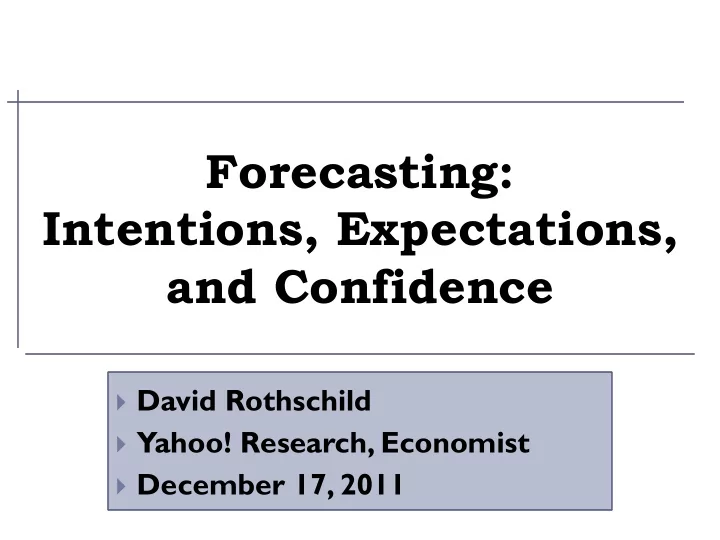

Forecasting: Intentions, Expectations, and Confidence David Rothschild Yahoo! Research, Economist December 17, 2011
Forecasts: Individual-Level Information Gather information from individuals, analyze it, and aggregate that information into forecasts of upcoming events. Make forecasts more efficient. Make forecasts more versatile. Make forecasts more economically efficient.
Two Methods of Aggregating Individual- Level Information into Forecast: Polls versus Prediction Markets Sample Selection: random sample of representative group versus self-selected group Question: intention versus expectation Aggregation: average versus weighted by money (proxy for confidence) Incentive: not incentive compatible versus incentive compatible
Article 1 … Forecasting Elections: Voter Intention versus Expectation When polling individuals in order to forecast an upcoming election, which question creates a more efficient and versatile forecast? Voter Intention: Who would you vote for if the election were held today? Voter Expectation: Who do you think will win the election? Motiving Idea: Intention: individual Expectation: individual, social network, central signal
Forecasting the President Year Race Actual result: %Intended to %Expect % voting for vote for the winner winner winner 1952 Eisenhower beat Stevenson 55.4% 56.0% 56.0% 1956 Eisenhower beat Stevenson 57.8% 59.2% 76.4% 1960 Kennedy beat Nixon 50.1% 45.0% 45.0% 1964 Johnson beat Goldwater 61.3% 74.1% 91.0% 1968 Nixon beat Humphrey 50.4% 56.0% 71.2% 1972 Nixon beat McGovern 61.8% 69.7% 92.5% 1976 Carter beat Ford 51.1% 51.4% 52.6% 1980 Reagan beat Carter 55.3% 49.5% 46.3% 1984 Reagan beat Mondale 59.2% 59.8% 87.9% 1988 GHW Bush beat Dukakis 53.9% 53.1% 72.3% 1992 Clinton beat GHW Bush 53.5% 60.8% 65.2% 1996 Clinton beat Dole 54.7% 63.8% 89.6% 2000 GW Bush beat Gore 49.7% 45.7% 47.4% 2004 GW Bush beat Kerry 51.2% 49.2% 67.9% 2008 Obama beat McCain 53.7% 56.6% 65.7% Simple average 57.5% 56.7% 68.5% 5
Contribution 1: Expectations Possess Untapped Information Expectation question forecasts winner more often and translates into estimated vote share and probability of victory with more accuracy. Rothschild (2009) Rhode & Strumpf (2004) and Alford (1977)
Predicting the winner of a state’s electoral college The winner was picked by a majority of respondents to the question on: Voter intentions: in 239 / 345 races = 69% Voter expectations: in 279 / 345 races = 81% Difference in proportions: z=3.52*** All Races Where the methods disagree Both wrong 45 races (13%) Expectations correct Disagree 63 races 83 races (76%) (24%) Both correct 217 races (63%) Intent correct 20 races (24%)
Root Mean Square Error = 0.151 Root Mean Square Error = 0.151 Root Mean Square Error = 0.076 1.0 1.0 1.0 Mean Absolute Error = 0.115 Mean Absolute Error = 0.115 Mean Absolute Error = 0.056 Correlation = 0.571 Correlation = 0.571 Correlation = 0.593 0.9 0.9 0.9 0.8 0.8 0.8 0.7 0.7 0.7 0.6 0.6 0.6 0.5 0.5 0.5 0.4 0.4 0.4 0.3 0.3 0.3 0.2 0.2 0.2 0.1 0.1 0.1 45-degree line 45-degree line 45-degree line 0.0 0.0 0.0 0.0 0.0 0.0 0.1 0.1 0.1 0.2 0.2 0.2 0.3 0.3 0.3 0.4 0.4 0.4 0.5 0.5 0.5 0.6 0.6 0.6 0.7 0.7 0.7 0.8 0.8 0.8 0.9 0.9 0.9 1.0 1.0 1.0 Efficient Intention-Based Forecast: E[Vr|Vr(hat)] ... (Based on Raw Dem Intention) Proportion Who Intend to Vote Democratic: Vr(hat) Proportion Who Intend to Vote Democratic: Vr(hat)
Root Mean Square Error = 0.209 Root Mean Square Error = 0.209 Root Mean Square Error = 0.060 Root Mean Square Error = 0.209 1.0 1.0 1.0 1.0 Mean Absolute Error = 0.175 Mean Absolute Error = 0.175 Mean Absolute Error = 0.175 Mean Absolute Error = 0.042 Correlation = 0.765 Correlation = 0.765 Correlation = 0.765 Correlation = 0.768 0.9 0.9 0.9 0.9 0.8 0.8 0.8 0.8 0.7 0.7 0.7 0.7 0.6 0.6 0.6 0.6 0.5 0.5 0.5 0.5 0.4 0.4 0.4 0.4 0.3 0.3 0.3 0.3 0.2 0.2 0.2 0.2 0.1 0.1 0.1 0.1 45-degree line 0.0 0.0 0.0 0.0 0.0 0.0 0.0 0.0 0.1 0.1 0.1 0.1 0.2 0.2 0.2 0.2 0.3 0.3 0.3 0.3 0.4 0.4 0.4 0.4 0.5 0.5 0.5 0.5 0.6 0.6 0.6 0.6 0.7 0.7 0.7 0.7 0.8 0.8 0.8 0.8 0.9 0.9 0.9 0.9 1.0 1.0 1.0 1.0 Efficient Expectation-Based Forecast: E[Vr|Xr(hat)]...(Based on Raw Dem Expectation) Proportion Who Expect the Democrat to Win: Xr(hat) Proportion Who Expect the Democrat to Win: Xr(hat) Proportion Who Expect the Democrat to Win: Xr(hat)
Recommend
More recommend